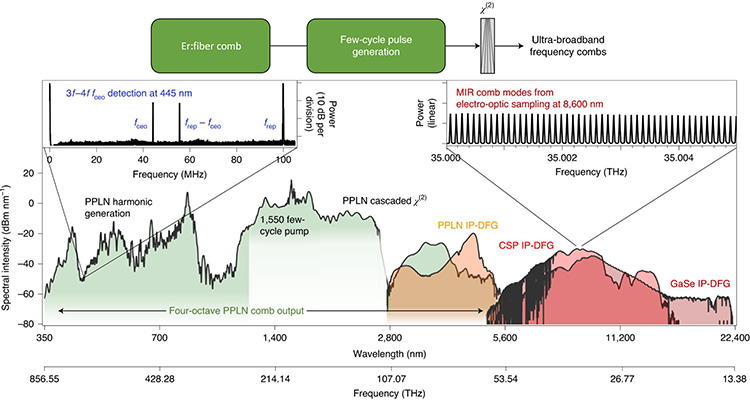 Top: Schematic of scalable short-pulse generation and nonlinear frequency conversion. Bottom: Six-octave frequency-comb spectrum. Colored spectra were achieved under four different experimental conditions. Upper left: fceo measurement at 445 nm. Upper right: 100-MHz comb modes from dual-comb electro-optic sampling. [Adapted from D.M.B Lesko et al. Nat. Photon. 15, 281 (2021)]
Top: Schematic of scalable short-pulse generation and nonlinear frequency conversion. Bottom: Six-octave frequency-comb spectrum. Colored spectra were achieved under four different experimental conditions. Upper left: fceo measurement at 445 nm. Upper right: 100-MHz comb modes from dual-comb electro-optic sampling. [Adapted from D.M.B Lesko et al. Nat. Photon. 15, 281 (2021)]
Applications such as broadband infrared microscopy, protein structure determination, standoff trace-gas detection and atomic timekeeping all demand robust, compact and coherent broadband light sources. Spectroscopy generally employs different light sources for each wavelength span of interest. However, using a single coherent source that can probe absorption signatures in multiple spectral bands enables correlated, high-fidelity measurements of simultaneous processes crucial to basic and analytical science.
Direct broadband coherent laser emission is limited, so schemes for generating such light commonly rely on nonlinear conversion from the near-infrared (NIR) to the mid-infrared (MIR) and ultraviolet (UV). In recent work, we leveraged robust and scalable fiber technology in the 1550-nm band to produce high-power, few-cycle pulses; those pulses, in turn, subsequently drove second-order (χ(2)) nonlinear optical processes and provided frequency-comb light from 350 nm to beyond 22,000 nm.1
In our study, we exceeded the power limits of conventional core-pumped fiber amplifier designs2,3 while still maintaining few-cycle pulses that can efficiently drive χ(2) processes that yield extremely broad coherent spectra. The pulses from a 100-MHz polarization maintaining Er:fiber oscillator were first amplified in erbium/ytterbium double-clad fiber, which can provide powers 10 times greater than core-pump fibers. Spectral broadening to a bandwidth of around 50 THz was achieved in normal-dispersion nonlinear fiber, followed by temporal compression in fused silica. This provided 9.4-fs pulses with peak powers of 0.56 MW. We further demonstrated scaling to provide 10-MW, 100-nJ pulses.
To generate 6-octave frequency-comb coverage (350 to 22,400 nm), the 9.4 fs pulse was focused into three χ(2) nonlinear crystals. Spectra from bulk periodically poled MgO-doped lithium niobate (PPLN) spanned 4 octaves (350-5600 nm) simultaneously by taking advantage of its strong χ(2) nonlinearity and broad transparency. Intrapulse difference-frequency generation in cadmium silicon phosphide (CSP) and gallium sulfide extended the coverage (5–13 and 5.6–22.4 µm, respectively), yielding a spectral density higher than infrared synchrotrons. The corresponding time domain is a 100-MHz pulse train of few-cycle carrier-envelope phase-stabilized transform- limited pulses (less than 60-fs duration at 35 THz or 8 µm), which can seed parametric amplification.4
We believe that this technique provides a path to robust, technologically mature Er:fiber frequency combs with intensities greater than 10 TW cm–2, which should enable the exploration of extreme-UV combs and attosecond pulses in solids and gases without the need for enhancement cavity geometries.
Researchers
D.M.B. Lesko, H. Timmers, S. Xing, A. Kowligy, A.J. Lind and S.A. Diddams, National Institute of Standards and Technology and University of Colorado, USA
References
1. D.M.B Lesko et al. Nat. Photon. 15, 281 (2021).
2. D. Brida et al. Las. Photon. Rev. 8, 409 (2014).
3. M.E. Fermann et al. Phys. Rev. Lett. 84, 6010 (2000).
4. U. Elu. Optica 4, 1024 (2017).

